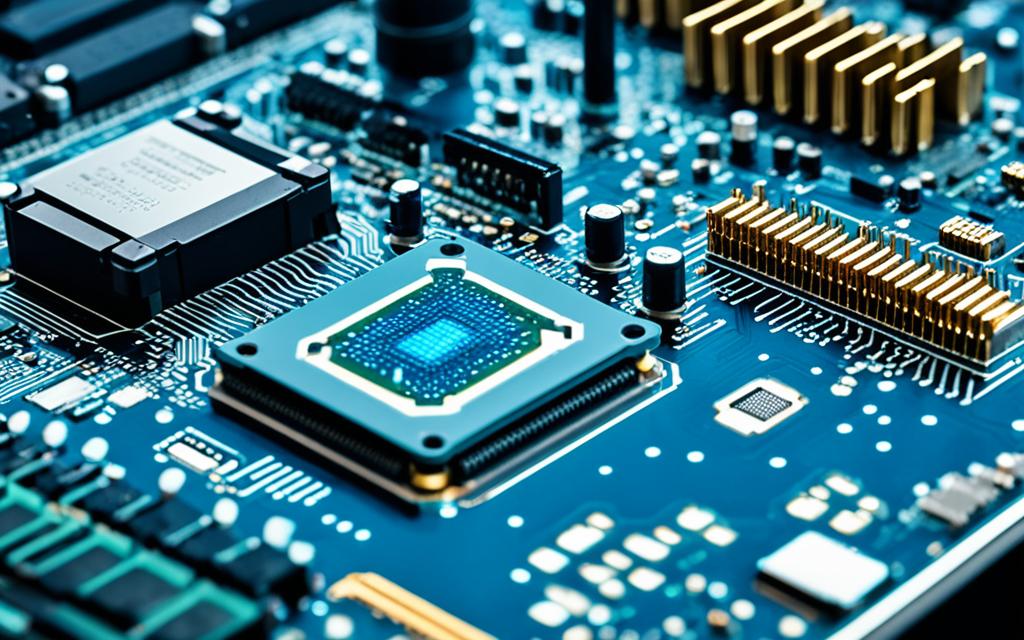How Much Is a Motherboard? Price Guide & Factors
The motherboard is like a computer’s heart, deciding how well it performs. But understanding what makes motherboards cost more is tricky. We will dive into the key parts and features that raise a motherboard’s price. This knowledge will help you choose wisely for your computer without breaking your budget.
If you’re setting up a new gaming setup, making your current PC better, or even building something for work, knowing about how much a motherboard costs and other factors is crucial. It will guide you towards the best affordable motherboards. It ensures you get the most for your money, finding the best motherboard deals.
Whether you’re looking at basic options or the top-of-the-line, we’ll look at what matters most for your money in motherboards. You’re about to learn how to get great performance without spending too much. Ready to learn about motherboard prices and make your PC both strong and affordable!
Understanding Motherboard Pricing
Motherboard prices vary for many reasons. It’s not just about the parts inside. It also depends on the brand and what the board can do. Knowing these things will help you make a smart choice when you’re building or upgrading your computer.
Components and Features Affecting Cost
A motherboard’s price changes with the stuff it has. More expensive ones have better processors, more memory slots, and other cool features. Cheaper boards don’t have all these extras.
Here’s what makes motherboards pricier:
- Processor socket type and compatibility
- Memory support (DDR4, DDR5, etc.)
- Number and type of storage interfaces (SATA, M.2, etc.)
- Expansion slots (PCIe, M.2, etc.)
- Networking capabilities (Ethernet, Wi-Fi, Bluetooth)
- Power delivery and cooling systems
- Overclocking capabilities and advanced settings
Brand Reputation and Market Positioning
The motherboard maker’s fame and place in the market also change the price. Big names with great products usually charge more. But you can find good deals with less well-known brands.
What the brand does in research, how they make the boards, and their help if something goes wrong, all increase the cost. People often spend more to feel sure they’re getting something good from a brand they trust.
Mainstream vs. High-End Motherboards
Motherboards come in two main types: mainstream and high-end. Knowing the difference helps choose what’s best for our PC projects. It’s about finding the right mix of power and cost.
Mainstream motherboards are for most of us. They offer essential features at good prices. This includes things like lots of RAM slots, places for graphics cards, and many ways to plug things in. They’re priced in the middle range, good for those watching their wallet.
High-end motherboards, however, are for the serious user. These are packed with top-notch performance and extras. They have the latest technology, more slots for cards, fast storage, and premium sound. They cost more but give a big boost in performance.
| Feature | Mainstream Motherboards | High-End Motherboards |
|---|---|---|
| Chipset | Mid-range to upper-mid-range | High-end, enthusiast-grade |
| Power Delivery | Adequate for most builds | Robust, with advanced power regulation |
| Connectivity | Sufficient for typical usage | Extensive, with multiple high-speed interfaces |
| Overclocking Support | Basic, with limited options | Comprehensive, with advanced controls |
| Price Range | $100 to $300 | $200 to $500+ |
Knowing what’s different between them helps us pick. Mainstream options are super for most. But, for those wanting the best, high-end motherboards unleash complete system power. It’s all about the features and what fits our budget.
how much is a motherboard
Building or upgrading a computer? The motherboard is key and affects your budget. Motherboard prices vary a lot, from cheap to mid-range to high-end. We’ll talk about the cost of motherboards at different levels to help you decide.
Entry-Level Motherboard Pricing
Entry-level motherboards start at about $50 and go up to $150. They’re good for basic jobs like surfing the web and making documents. These lower-priced boards might not have all the high-end features, but they still work well for many people.
Mid-Range Motherboard Costs
Looking for something more capable? Mid-range motherboards cost between $150 and $300. They include more features, better connectivity, and support for fancy processors. These boards are great for those who want more without spending too much.
It’s key to think about your needs when looking at motherboards. You might not need a pricey one if you only do simple tasks. But, if you want to do more with your computer, the cost of a better board might be worth it.
Finding the best motherboard means looking at your system as a whole. Think about your budget and what you’ll use your computer for. Knowing the different costs of motherboards helps you pick the right one for you. This way, you get what you need without overspending.
Form Factors and Their Impact on Price
The size and shape of a motherboard, called the form factor, really influences its price. The most common types are ATX and Micro-ATX. Each has its own perks and cost points.
ATX vs. Micro-ATX Motherboards
ATX boards are bigger and more versatile. They have more space for extra features. This makes them more expensive. On the other hand, Micro-ATX boards are smaller and cheaper. They fit the needs of those working with a tighter budget.
The cost differences between ATX and Micro-ATX boards often come down to several key factors:
- Micro-ATX boards are smaller, so they cost less to make.
- ATX boards have more slots for extra cards and memory, making them pricier.
- ATX boards may have better power systems, which can raise the cost too.
- Big brands tend to charge more for ATX boards, while Micro-ATX brands might be more affordable.
It’s crucial to think about what you really need in a motherboard. If you can do without the extra features of an ATX board, a Micro-ATX board might be just as good. It’s a smart way to save money while not missing out on what’s important.

Knowing how form factors affect prices helps you make a smart choice. This is key for staying within budget and meeting your computer’s needs.
Chipset and Socket Compatibility
Choosing a motherboard means understanding how the chipset and socket work together. The chipset connects the CPU, memory, and other parts. The socket lets specific processors fit onto the motherboard.
The chipset and socket selection will affect your PC’s abilities. Better chipsets and sockets offer more features but cost more. This makes choosing the right combination important for your needs and budget.
Chipset Compatibility
Motherboard chipsets decide what parts and processors you can use. Intel and AMD are major chipset makers. Each has its own needs for compatibility when you build or upgrade a PC.
- Intel chipsets like LGA1200, LGA1151, and more determine motherboard pricing and fit.
- AMD chipsets have socket types including AM4 and TR4, each with its own performance levels.
Socket Compatibility
The motherboard’s socket connects the CPU to the system. It must match the processor you use for everything to work well.
- For Intel, choose from LGA1200, LGA1151, and others.
- AMD options are AM4, AM3+, TR4, and more.
Getting the right chipset, socket, and CPU to work together is key. It influences your PC build’s total cost. Knowing these details helps pick the best for your needs without overspending.
| Chipset | Socket Type | Typical Motherboard Price Range |
|---|---|---|
| Intel H610 | LGA1200 | $70 – $120 |
| Intel Z690 | LGA1700 | $150 – $400 |
| AMD B550 | AM4 | $100 – $200 |
| AMD X570 | AM4 | $150 – $400 |
Future-Proofing and Longevity Considerations
When you get a new motherboard, think about how long it will stay useful. A good motherboard can support your PC system for many years. This means you can add better pieces over time. By choosing a motherboard with future upgrades in mind, you make a smart investment.
Upgrading and Expansion Capabilities
It’s essential that your motherboard can grow with you. Find one with many slots for adding new parts. For instance, it should have room for more graphics cards, fast storage, or other needed items.
Memory support is also key. Choose a model that supports lots of memory and fast speeds. This helps your PC keep up with new software and games.
- Prioritize motherboards with multiple PCIe and M.2 slots for future upgrades
- Look for motherboards that support high-capacity and high-speed memory modules
- Consider the longevity of the CPU socket and chipset compatibility to enable processor upgrades
By looking at motherboard upgrading and expansion capabilities, you make your system last longer. This way, you won’t need to change everything too soon.
Balancing Performance and Budget
Choosing the right motherboard means finding a balance between what it offers and the cost. We look through many types to find the best for our needs and wallet. This ensures we spend our money wisely.
Finding the Sweet Spot
The saying “you get what you pay for” isn’t always true for motherboards. While top-of-the-line ones have great features, they can be very costly. Entry-level motherboards are cheaper but might not meet our needs in the long run.
We must balance performance and our budget wisely. Researching and comparing different models is key. This way, we pick one that gives us the most for our money. We can get a powerful PC without spending too much.
The compatibility of the motherboard’s chipset and sockets is crucial. It affects the type of processors and parts we can use. This choice will directly affect how well our system works. We make sure to pick features we truly need.
Also, we need to think about the future with our motherboard choice. Choosing one known for quality and that’s easy to upgrade can save us money later. It lets us keep our PC up to date as our needs change.
Finding the right balance between what we need and how much we’re willing to pay is key. This lets us create a powerful computer without spending more than necessary. We make a smart PC investment this way.
Tips for Scoring the Best Deals
To get the best motherboard prices, you need to be smart and look around. Check online stores often for sales and discounts. Also, keep an eye on official websites and big online shops for great deals.
Ask for price matches at big retailers. If you see a motherboard cheaper at another store, see if the one you’re at will match the price. This is a good way to save money while still getting good customer service.
It’s also wise to compare prices from different online sellers. Spend time looking at prices on various trusted sites to find the lowest price. With these strategies, you can find a great motherboard for your computer that fits your budget.




